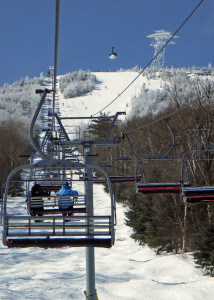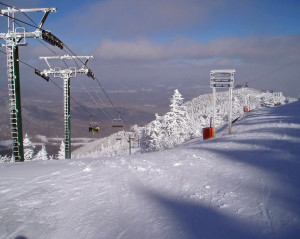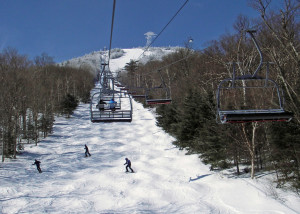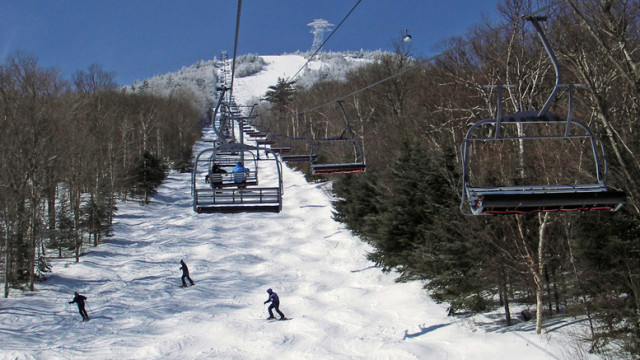
Even if skiing and snowboarding were not allowed there, Jay Peak would be worth visiting just for the scenery. Thank heavens skiing is allowed, though, because this mountain was truly meant to be a ski destination. Viewed from the surrounding farm country, the exposed rock summit looms spectacularly, ribboned with steep chutes. The peak is often topped by a unique cloud formation (known by its friends as the “Jay Cloud”). If you are a cloud enthusiast, like me, you might recognize it as a species of altocumulus lenticularis. The Jay Cloud is a testament to the unique weather conditions here, which bless the resort with what is purportedly the highest annual snowfall of any East Coast resort.
Jay Peak seems like a considerable trip for many skiers and riders. Driving from Boston or New York you have to pass nearly every major New England ski area and travel all the way to the Canadian border just to get there. But it’s really an easy shot up I-91, and the isolation is part of its draw. The slopes are generally uncrowded, and the resort has wonderfully old-world European flavor and hospitality, with close ties to nearby Quebec. Nearly half of the clientele is French Canadian , if je me souviens correctly (sorry, couldn’t resist . . .).
Jay has done a lot of work recently with a new slopeside hotel and a refurbished base lodge. That’s all wonderful, but more important is the fact that they haven’t tampered with the resort’s essential “Jayness.”
Take the tram, for example–a defining experience, one of the last two operating in the east (the other is at Cannon Mountain in New Hampshire). You have to ride the Jay Tram on a powder morning at least once in your life.

On this particular mid-February visit, the clouds were parting in the morning, and the tram took us up through several wispy patches of cloud into bluebird weather, which is not unusual for Jay Peak. Even though all the “major” storms this year have all gone south, and it hadn’t snowed at all for several days, the snow was still incredibly deep. I took my skis off in the trees near the top and sank in up to my waist.
Jay Peak is known as a tree-skiing mecca, because of the terrain and their “boundary to boundary” open skiing policy. The trees are, for the most part, well-spaced enough for making turns. Finding glades is simple at Jay–you could not throw a brick anywhere on the mountain without hitting a tree run. Of course there are certain classics that must be skied, like Deliverence and Valhalla, but the thing to do is jump into the woods and explore. Just be careful. Signs posted around the mountain warn wisely against accessing the glades after 3 pm, and advise all skiers and riders to travel in groups of three when riding off-piste. This is some of the most serious terrain in New England.

Even if it hasn’t snowed for a while, there is usually still fresh snow to be had at Jay. The Beaver Pond Glade and Valhalla were skied out, so my friends and I headed to the Face. The Face offers what is possibly the most harrowing in-bounds skiing in New England. On a better snow year the small trees are completely covered and the more technical lines are skiable. I peered hopefully down the Saddle, which is, in the best of conditions, a 45 degree bottleneck chute, barely wider than a ski length. It was a wall of solid blue ice. Cooler heads prevailed, and we hiked along the ridge to Radio Shack, an un-posted tree run below a ruined weather station. Even if narrow chutes are not your thing, be sure to take this hike, just for the view. From Radio Shack we traversed into the steeps below the Face, and were rewarded with fresh turns, as well as a few intimate moments with the trees (having friends with you is particularly useful when you need help extricating yourself from a krumholz tree).
After that is was off to Timbucktoo, a lower peak serviced by the Jet Triple. This area is even less frequented than the Tram, and the snow was excellent. If you like moguls, Jet is a classic bump run somewhat along the lines of Sunday River’s White Heat or Killington’s Outer Limits, complete with the requisite cheering section from the lift above. Hot Dog bumps skiers will also enjoy the aptly named Power Line. Watch out! There literally are electrical poles.
My leg was still bum from a skiing accident, so I spent much of the day doing something I had never done at Jay Peak: carving the cruising runs. This turned out to be a bit of serendipity, since the twisty trails ski like a Super G course, and I was trying to get in the Olympic spirit for the upcoming games. Can Am and JFK are both great for high speed turns.
Reading this, you may have gleaned that Jay Peak is a very ‘expert’ sort of mountain. Unfortunately, Jay is somewhat lacking for mellow terrain, and there’s not really an easy way to get down from the top. Moreover, a lot of the intermediate trails are downright scary, like Vermonter, which makes me feel as though I am about to fall off the edge of the earth, and St. George’s Prayer, which has a thrilling double fall line. Also, some of the groomed trails are not maintained as regularly as is the case at more glizty resorts, which can make the blue squares feel very black diamond, especially when conditions are icy. Still there are some intermediate gems, such as Kokomo, a picturesque trail that winds gently through the birch trees.
A great surprise for me was the work Jay Peak has done on their terrain parks. In years past Jay barely had any jumps, and what few there were weren’t very good. Things have changed! The big thing now in snowparks are jump lines, which are multiple hits placed in a row. Jay has this down to a science. The amount of planning and snowmaking that went into Jay’s expert jump line blew me away. The jumps had perfect take-offs with long, mellow transitions, and the landings were enormous, over sixty feet long. What this means is that you can choose to go 20 feet or 70 feet off the same jump and still land safely. Either way, the landing was soft as a feather. I cursed my hurt leg freely, and stood at the edge watching a few snowboarders flying overhead. I immediately started making plans for a return trip, which is exactly what happens every time I ski at Jay.
If it’s northern snow you want, you know where to go: Jay Peak. It’s not Canada, but its close.


